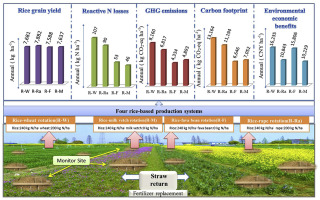Journal of Cleaner Production ( IF 9.7 ) Pub Date : 2018-05-16 , DOI: 10.1016/j.jclepro.2018.05.115 Siyuan Cai , Cameron M. Pittelkow , Xu Zhao , Shenqiang Wang

|
Achieving reductions in nitrogen (N) losses and carbon (C) emissions without enduring a yield penalty is an environmental and economic challenge in sustainable rice production. The use of legumes as a winter crop in rice rotations may provide environmental benefits by reducing synthetic N inputs, yet few studies have integrated long-term field measurements of cropping system N and C dynamics with life cycle assessment (LCA) and net ecosystem economic benefits (NEEB) to determine whether legumes can improve environmental performance while minimizing tradeoffs related to yields and economic returns. We evaluated four contrasting rice cropping rotations (Rice-wheat (R-W); rice-rape (R-Ra); rice-fava bean (R-F); and, rice-milk vetch (R-M)) over six years to determine N input and output balances, methane (CH4) emissions, and soil C changes. These field observations were then incorporated into LCA and NEEB to estimate C footprint, economic and environmental benefits. Results showed that R-F and R-M maintained rice yield but reduced annual synthetic N inputs by 50–63% compared with the conventional R-W and R-Ra rotations, leading to consistent reductions in reactive N losses (ammonia (NH3) volatilization: 39–48%; N runoff: 66–82%; N leaching: 14–34%; and nitrous oxide (N2O) emissions: 40–64%). The estimated C footprint was 37–50% lower in R-F and R-M than R-W and R-Ra, largely owing to reduced fertilizer use which decreased direct soil N2O emissions as well as indirect emissions relating to reactive N losses. In contrast to N losses, there were no significant differences in CH4 emissions or soil C changes among rotations. When changes in N pollution and C footprint were accounted for in the economic assessment, R-F resulted in NEEB values similar to R-W, while substituting milk vetch as a winter crop reduced NEEB by 6–37%. In the first two study years before grain legume yields declined, NEEB for R-F was 38% greater than R-W, highlighting the potential for simultaneous environmental and economic benefits. This study demonstrated the potential of mixed winter grain/forage legumes-rice crop rotations to consistently reduce N pollution and C footprint while maintaining NEEB based on economic and environmental benefits.
中文翻译:

冬季豆类-水稻轮作可以减少氮污染和碳足迹,同时保持净生态系统经济效益
在不影响产量的前提下减少氮(N)损失和碳(C)排放是可持续水稻生产中的环境和经济挑战。在轮作中将豆科植物作为冬季作物使用可能会减少合成氮的投入,从而为环境带来惠益,但很少有研究将作物系统氮和碳动态的长期田间测量与生命周期评估(LCA)和生态系统净经济效益相结合。 (NEEB)来确定豆类是否可以改善环境绩效,同时最大程度地减少与产量和经济回报相关的折衷。我们评估了六个不同的水稻轮作季节(稻麦(RW);水稻油菜(R-Ra);水稻蚕豆(RF);以及水稻牛奶紫etch菜(RM)),以确定氮素的输入量和甲烷输出平衡(CH 4)排放和土壤碳变化。然后将这些现场观察结果纳入LCA和NEEB中,以估算碳足迹,经济和环境效益。结果表明,RF和RM维持水稻产量,但与常规RW和R-Ra轮作相比,每年合成氮的投入减少了50–63%,从而导致反应性氮损失(氨(NH 3)挥发)的持续减少:39–48 %;氮径流量:66-82%;氮淋失:14-34%;一氧化二氮(N 2 O)排放量:40-64%)。估计的RF和RM的C足迹比RW和R-Ra少37–50%,这主要是由于减少了肥料用量,减少了直接土壤N 2O排放以及与无功N损耗有关的间接排放。与氮损失相比,各轮次之间的CH 4排放量或土壤C变化均无显着差异。在经济评估中考虑了氮污染和碳足迹的变化时,RF得出的NEEB值与RW相似,而用紫v代替冬季作物则使NEEB降低了6%至37%。在豆类单产下降之前的前两年研究中,RF的NEEB比RW高38%,突显了同时带来环境和经济利益的潜力。这项研究表明,冬季谷物/牧草和大米与稻米的轮作混合有可能持续减少氮污染和碳足迹,同时基于经济和环境效益保持NEEB。











































 京公网安备 11010802027423号
京公网安备 11010802027423号